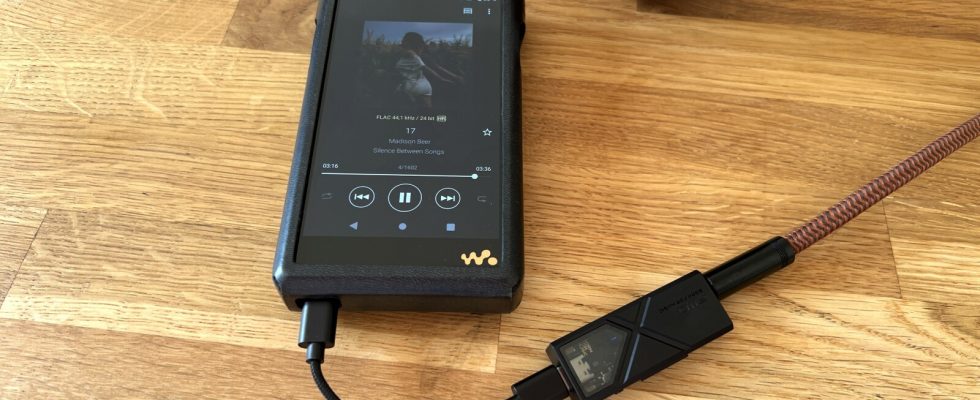The FiiO KA13 is a portable headphone amplifier and DAC with a lot of power. You can find out what the audio gadget can do in our test.
The FiiO KA13 is a new headphone amplifier in USB stick format with a lot of power. (Source: Netzwelt)
We recently tested the KA5 from FiiO for you, an ultra-compact DAC with an integrated headphone amplifier that can be used to operate wired headphones on a smartphone or game console. With the KA13 there is now a new, slightly cheaper version of such a USB dongle.
The special thing about this model: The compact amplifier offers a lot of power via a switchable desktop mode, so that even large, power-hungry headphones can be operated with it. The special thing about it is the size, as it makes a large headphone amplifier for the desk almost unnecessary.
The KA13 can also be easily used on the go. It is also quite robust thanks to the metal housing. Compared to the KA5, there is more output power, but there are also a few compromises; after all, the compact headphone amplifier with DAC is significantly cheaper than the premium model. We were able to test the FiiO KA13 for some time and describe below what the little gadget can do.
Design, workmanship, scope of delivery
The KA13 is also only as big as a USB stick. Measuring 5.6 x 2.2 x 1 centimeters, it can be stored in any bag. Compared to very cheap dongles, this model has the advantage that the connection cable is not permanently connected to the device.
The scope of delivery includes two short USB cables – a USB-C to USB-C and a USB-C to Lightning for use on the iPhone, even if the Lightning port becomes obsolete with the iPhone 15. There is also a USB-A to USB-C adapter, which means the KA13 can also be used on a notebook or desktop PC. However, the included cables are only around ten centimeters long, which is why you may have to use a separate cable when using it on a PC.
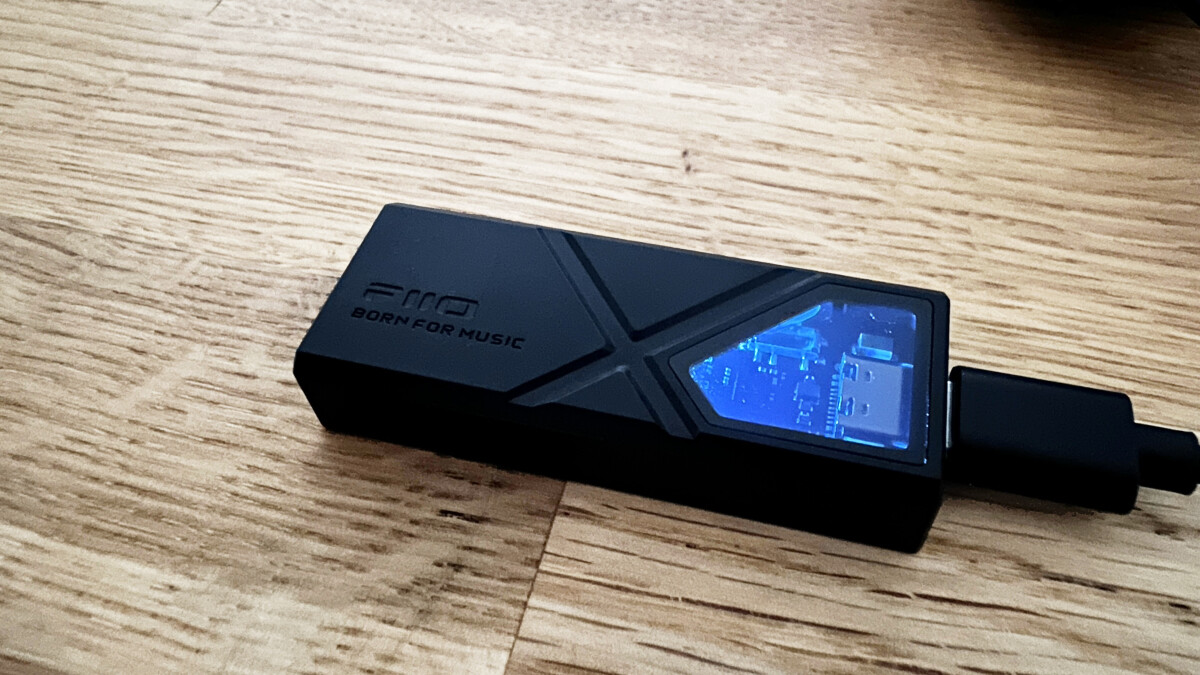
A glass surround allows a view inside. The RGB LED provides information about the audio quality. (Source: Netzwelt)
The back of the amplifier is made of tempered glass. Behind this is the manufacturer’s logo, the model name and various license plates and features. The front is clearly different from the KA5. It has a large, notched “X” and offers a small transparent area (also protected by tempered glass) that allows a view of the inner workings.
There is no display, but there is an RGB LED inside that provides information about the audio quality:
- Light blue: PCM with a sample rate of 48 kilohertz or more
- Yellow: PCM with a sample rate of less than 48 kilohertz
- Green: Audio material in DSD format
The KA13 also has two buttons, each with two functions. You can use it to change the volume and skip to the previous or next song. Another slide switch is for desktop mode. If this is activated, the output power is increased to the maximum. If you use low-power headphones such as in-ear headphones, you can leave the mode deactivated.
As with the KA5, there is a 4.4 millimeter headphone output (Pentaconn, balanced) as well as a standard 3.5 millimeter jack socket, which also serves as an optical output (SPDIF). For example, the amplifier / DAC can be used with a hi-fi system.
Equipment and technical data
Two digital-to-analog converters are used in the FiiO KA13. These are two CS43131 from Cirrus Logic. They are intended to offer excellent audio quality with low power consumption at the same time. The DAC supports decoding of PCM up to 384 kilohertz and 32 bit as well as DSD256. The KA5 can do more here – but you will hardly encounter such high sample rates in everyday life, so this is negligible.
What’s missing is support for the MQA (Master Quality Authenticated) format. This is bearable as it is rarely used in streaming services – actually only in Tidal and this provider also switched to the FLAC format some time ago.
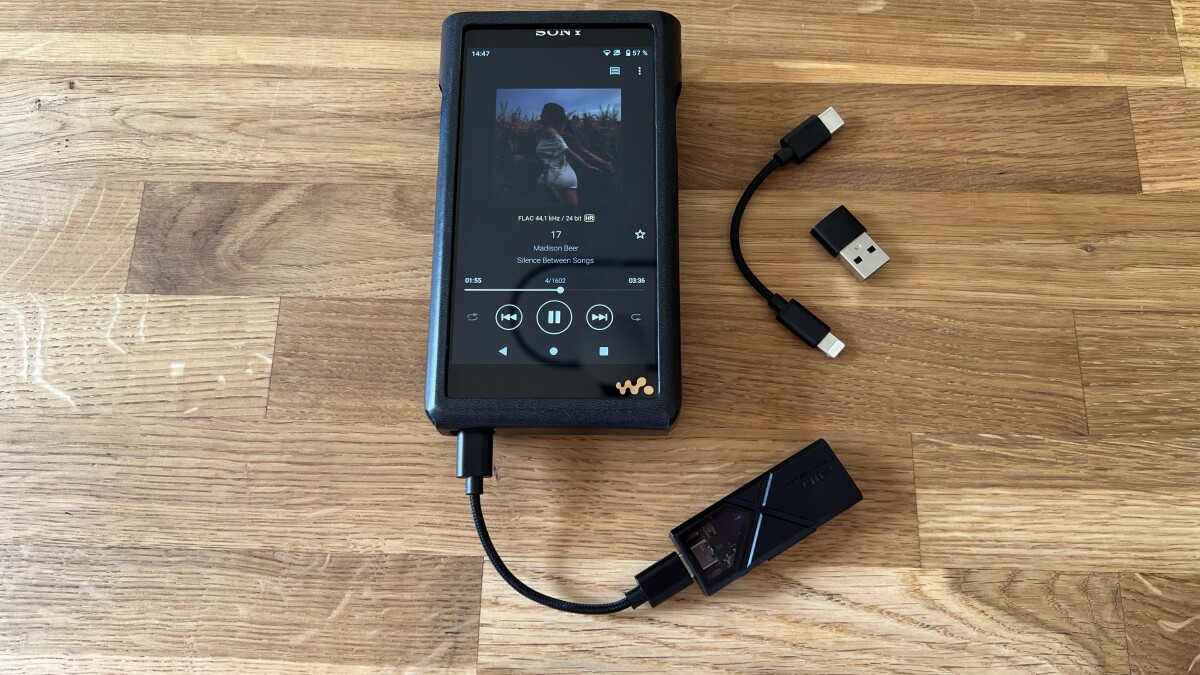
The scope of delivery includes two USB cables and an adapter for operation on all kinds of devices. (Source: Netzwelt)
The integrated headphone amplifier works with two 8262 amplifier chips, which are said to be particularly powerful and low-noise at the same time. They deliver up to 170 milliwatts per channel on the 3.5 millimeter connection and up to 550 milliwatts on the Pentaconn socket. For comparison: Current Sony Walkmans have a maximum of 1.1 milliwatts. In the table below you will find an overview of the most important data.
| FiiO KA13 | |
|---|---|
| Colors | Black silver |
| DAC chipset | 2x Cirrus Logic CS43131 |
| USB input | USB-C |
| Device dimensions | 56.3 x 22 x 10.5 millimeters |
| Weight | 18.5 grams |
| display | no display |
| steering | Multifunction buttons |
| Audio interface modes | UAC2 |
| Exits | 3.5mm, 4.4mm, S/PDIF |
| Output power 3.5mm | L+R ≥ 170mW + 170mW (32Ω PO/THD+N |
| Output power 4.4mm | L+R ≥ 550mW + 550mW (32Ω BAL/THD+N |
| Noise level | P.O |
| Output impedance 1 | |
| Output impedance 2 | |
| THD+N 1 | |
| THD+N 2 | |
Fiio KA13 technical information
Compared to the KA5, the KA13 offers a significantly higher output power. On the other hand, the output impedance and the background noise are slightly higher than with the other model. The USB amplifier does not have an integrated battery and draws its energy from the connected device. This reduces the running time slightly on smartphones, for example, but it has the advantage that you don’t have to charge the amplifier.
Important settings, controls and app connection
The KA13 can be configured via the FiiO app. Since the device does not have a display, this is the only way to change the settings. However, the software is only available for Android phones, meaning iPhone users cannot use all functions, which is suboptimal.

You can change important settings using the FiiO app. (Source: FiiO)
In the program, the optical output must be activated via the 3.5 millimeter audio jack, otherwise operation is not possible. In addition, the way RGB LEDs work can be changed. Here you can choose between “Turn on”, “Turn off until the device restarts” and “Turn off”.
The app doesn’t offer an equalizer, but does provide some DAC filters that change the sound in detail, such as trimming the high frequencies a little to make the sound seem warmer. There are a total of four filters here, but if desired these can also be switched off using the “Non over-sampling filter”.
Especially with regard to the app, it quickly becomes apparent that the KA13 offers significantly fewer functions than the KA5. However, the features are completely sufficient for normal everyday use. However, there is a damper in the audio interface mode. Here the KA13 only supports UAC 2, which is why operation on the Nintendo Switch or PS5 is not possible. If you want this, we recommend the FiiO KA5.
Audio quality
Despite the supposedly higher background noise, we have no complaints about the audio quality of the DAC – and to be honest: we don’t hear any background noise during testing. When the music stops, there is silence. The FiiO KA13 delivers brilliant sound without distortion on all frequencies like the KA5.
We tried out the device on various devices, including various smartphones, a Walkman and a PC. Headphones with a traditional jack connection and a Pentaconn connection were also used.
The filters included in the app are like this: In a direct AB comparison, the sound changes in detail, but hardly noticeably. In a blind test we probably wouldn’t notice the differences. A proper equalizer would be nice here, as it changes the sound more noticeably.
The audio dongle works on a notebook or PC without any noticeable latency. This means watching films or series is no problem. Is it enough to convince professional gamers? You have to decide that for yourself. For us, the latency was perfectly fine during casual gaming.
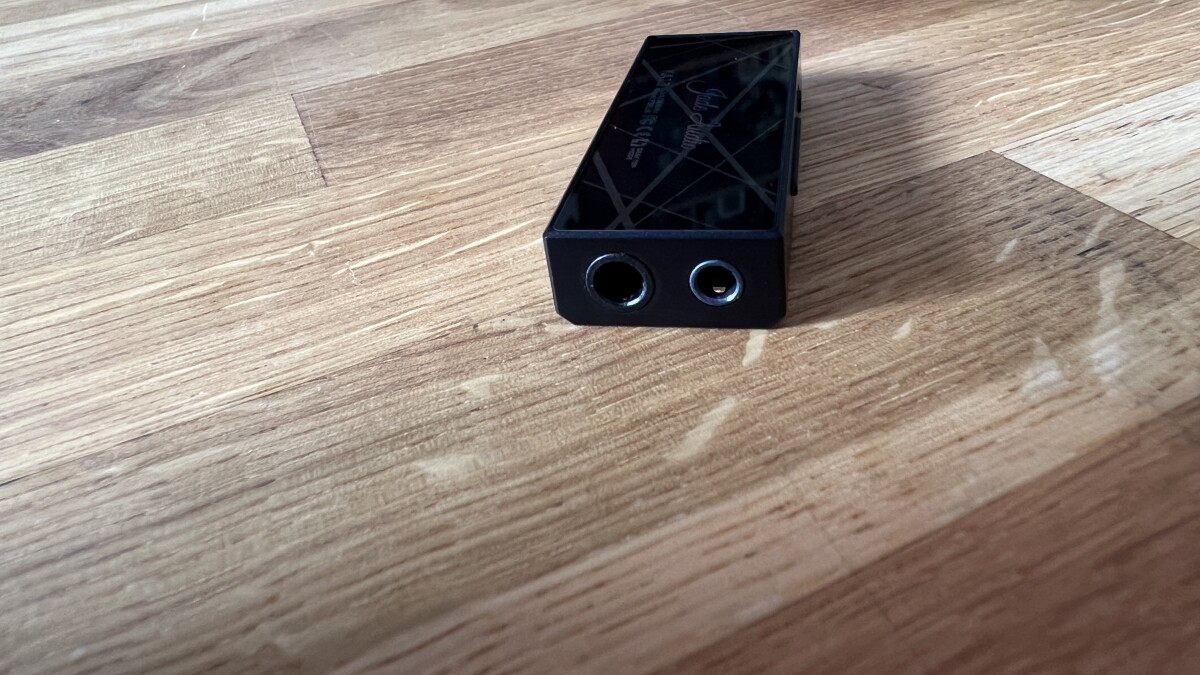
Headphones with 3.5 millimeters and 4.4 millimeters can be connected to the KA13. (Source: Netzwelt)
In operation, the KA13 shows its strengths on the one hand on the Sony Walkman, which in Germany is delivered with a volume limit and cannot operate various headphones at an adequate volume. On the other hand, you can use the small device to listen to Hi-Res audio on the iPhone, which is not possible on the Apple cell phone without an external DAC.
A mistake you shouldn’t make: If you wear in-ear headphones, don’t accidentally activate desktop mode. It almost burst our eardrums, it was so loud. You should therefore be careful with low-power earphones, as the device outputs a lot of power. If the volume is not turned down, it will be painful.
Price and availability
The FiiO KA13 has been on sale since September 18th, but not yet in Germany. If you are interested, you can already get the headphone amplifier with DAC Aliexpress Buy in black and silver. The price is 93.66 euros. This means that the model is around 50 euros cheaper than the KA5.
Advertisement
The start in Germany is coming soon. However, there is no exact date yet.
Conclusion
The FiiO KA13 is very compact and at the same time surprisingly powerful. Except for headphones that are extremely difficult to operate, the device should be sufficient for many people as a replacement for a large headphone amplifier.
Another strength of the KA13 is that you can use wired headphones on devices that no longer offer a jack connection. Maybe you also have headphones with a Pentaconn plug, which can only be used on expensive audio players without an adapter.
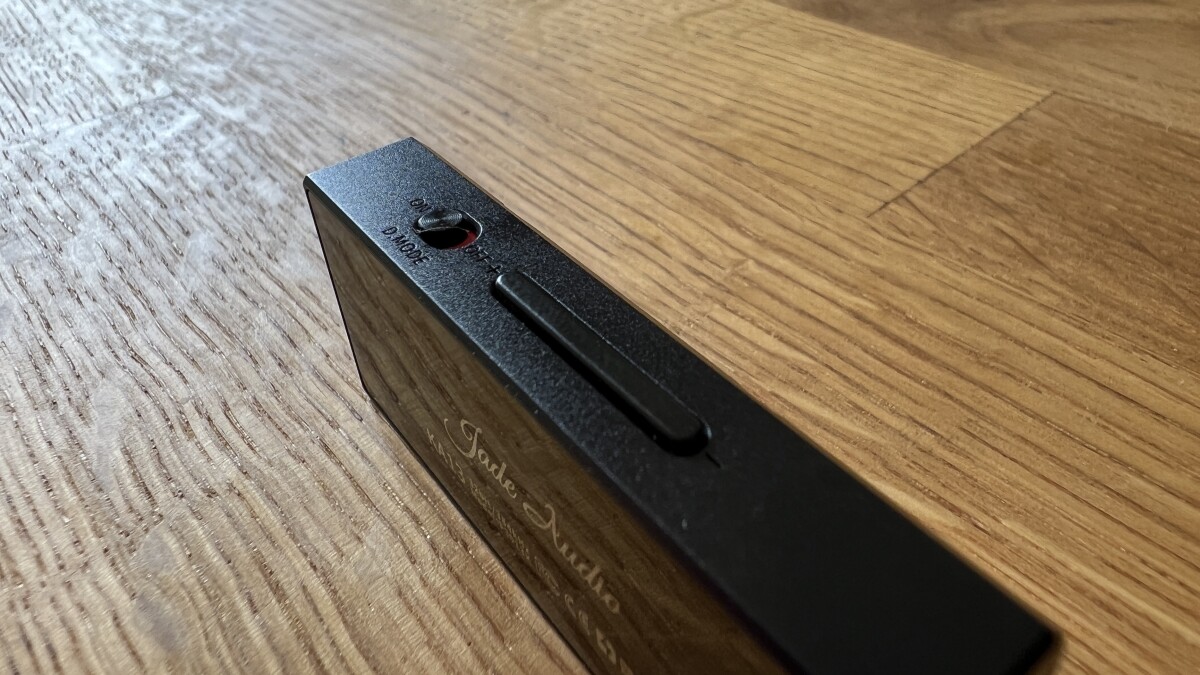
Volume and playback can be controlled using the multi-function buttons. The slide switch enables or disables desktop mode. (Source: Netzwelt)
And last but not least, you get real, uncompressed audio in the highest resolution from Apple devices, which doesn’t even work normally with Apple’s Lightning to jack adapter.
Compared to the KA5, however, you have to live with compromises due to the cheaper price. Due to the lack of a display, operation is easiest with an Android device if you want to use the optical output. Unfortunately, the KA13 also lacks UAC 1 mode, which is why it is not suitable for use on game consoles. If you can do without it, you can get a very powerful amplifier with an excellent DAC for under 100 euros.
We liked that
- Very compact and light
- Robust workmanship
- Cable and adapter included
- Very high amplifier power for its dimensions
- No audible background noise
- Headphone output with 3.5 and 4.4 millimeters
- Optical output
We didn’t like that
- Cannot be used on the Nintendo Switch
- Optical output can only be activated via the Android app
- No MQA support
Don’t miss anything with this NETWORK WORLDNewsletter
Every Friday: The most informative and entertaining summary from the world of technology!

